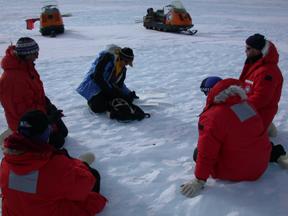8 December, 2002
Goodwin Nunatak
We finally made it to our field camp! There is such a
sense of relief and excitement among the team members
for finally beginning our meteorite searching. An
LC-130 (ski equipped cargo plane), operated by the New
York Air National Guard, dropped us off at the
abandoned Beardmore South Camp a couple of days ago.
At first I thought I'd feel stranded when the plane
left, but I actually felt relieved when it left.
The next day we took our gear and snowmobiles on a 5
1/2 hour traverse to Goodwin Nunatak (not named after
my student, Mike Goodwin). This camp is on the
boundary of the Polar Plateau and the Transantarctic
Mountains. This makes sense because it is where the
Antarctic Ice Cap backs up against the mountains.
When this happens, it flows upward and is ablated by
the wind. Meteorites are revealed in these "blue ice"
areas.
Blue ice does not necessarily mean that meteorites are
the only rocks. Some of the blue ice contains
moraines with local rocks mixed in. Some of the local
rock is dark and rounded making close observations
necessary. On the plateau, every rock is a meteorite,
making searching easier, but on the margin, its a
little trickier. There are strategies to finding
meteorites in the moraines. We found they collected
in the wind scoops that formed around boulders. We
would often find a couple of meteorites mixed among
other rocks that blew into the wind scoop.
The blue ice looks like a frozen ocean. In fact, if I
saw a picture of one hill without knowing it was
Antarctica, I'd think I was looking at a giant swell
on the ocean. The wind carves the ice into smaller
waves called "Sastrugi," that almost look like
whitecaps on the swell. In other areas the ice is
almost flat, like a calm frozen ocean.
Our meteorite searching was extremely successful
today. Although we weren't doing any systematic
searching, we still found 23 meteorites to add to the
21 we found yesterday. A great deal of our success
was due to one of our leaders, John Schutt. John has
an amazing eye for meteorites and is a good geologist.
He has been working with ANSMET for 22 years and is
extremely knowledgeable about the regional geology. I
find myself frequently asking him about the local
formations. Today, John took us to a moraine, a
deposit of assorted rocks from a variety of areas. We
found petrified wood, agate geodes, zeolites (crystals
that form in gas pockets in basaltic lava flows).
John has donated samples from this area to the Crary
Lab at McMurdo. It was an amazing lesson in Antarctic
historical geology.
We had most of our success at a place unofficially
named Scoraine Moraine, after Robbie Score, a former
ANSMET team member. I hope we get a chance to go
back. It was late in the day and I think we left a
lot behind. I can't explain the thrill at finding a
meteorite. Danny compares this to an Easter Egg hunt,
but I see it more like fishing. Sometimes you can't
catch them fast enough, and other times it goes for
hours without finding any. It's great to find
several, but finding a rare variety is just as
rewarding. I can't wait to get out there again to
find more.
Tomorrow, Carl rejoins our team and John goes to the
South Pole to meet up with the Rekki (Reconnaissance)
team.

ANSMET team collecting one of the first meteorites of the season
Contact the TEA in the field at
.
If you cannot connect through your browser, copy the
TEA's e-mail address in the "To:" line of
your favorite e-mail package.
|
